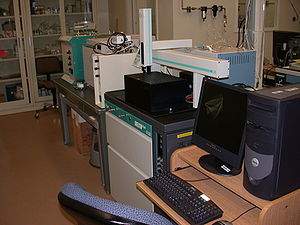Scientists use various dating methods to determine the age of the earth.
19.1.1 Radiometric Dating
By measuring the amount of Radioactive decay of a radioactive isotope with a known half-life, geologists can establish the absolute age of the parent material. A number of radioactive isotopes are used for this purpose, and depending on the rate of decay, are used for dating different geological periods. More slowly decaying isotopes are useful for longer periods of time, but less accurate in absolute years. With the exception of the radiocarbon method, most of these techniques are actually based on measuring an increase in the abundance of a radiogenic isotope, which is the decay-product of the radioactive parent isotope.
Some of the commonly-used techniques are:
• Radiocarbon dating. This technique measures the decay of carbon-14 in organic material and can be best applied to samples younger than about 60,000 years.
• Uranium-lead dating. This technique measures the ratio of two lead isotopes (lead-206 and lead-207) to the amount of uranium in a mineral or rock. Uranium-lead dating is applied to samples older than about 1 million years.
• Uranium-thorium dating. This technique is used to date speleothems, corals, carbonates, and fossil bones. Its range is from a few years to about 700,000 years.
• Potassium-argon dating and argon-argon dating. These techniques date metamorphic, igneous and volcanic rocks. They are also used to date volcanic ash layers. The younger limit of the argon-argon method is a few thousand years.
19.1.2 Luminescence Dating
Luminescence dating techniques observe ‘light’ emitted from materials such as quartz, diamond, feldspar, and calcite. Many types of luminescence techniques are utilized in geology, including optically stimulated luminescence (OSL), cathodo-luminescence (CL), and thermo-luminescence (TL).
19.1.3 Incremental Dating
Incremental dating techniques allow the construction of year-by-year annual chronologies, which can be fixed or floating.
• Dendrochronology
• Ice cores
• Lichenometry
• Varves
19.1.4 Correlation of Marker Horizons
Marker horizons are geological units in different geographic locations but which are of the same age. This allows age-equivalence to be established between different sites. For example, tephra is often used in archaeology.
19.1.5 Differences between Chronostratigraphy and Geochronology
It is important not to confuse geochronologic and chronostratigraphic units. Geochronological units are periods of time, thus it is correct to say that Tyrannosaurus rex lived during the Late Cretaceous Epoch. Chronostratigraphic units are geological material, so it is also correct to say that fossils of the genus Tyrannosaurus have been found in the Upper Cretaceous Series.


Be First to Comment